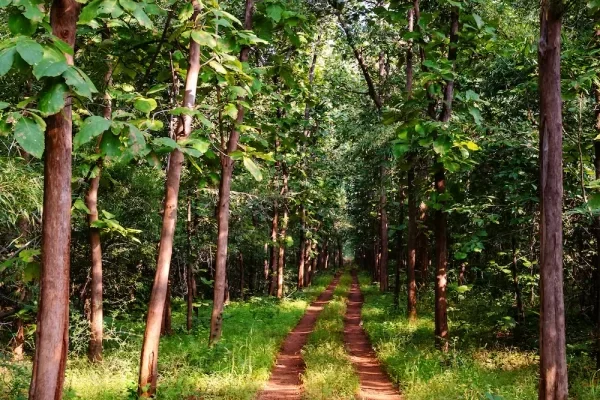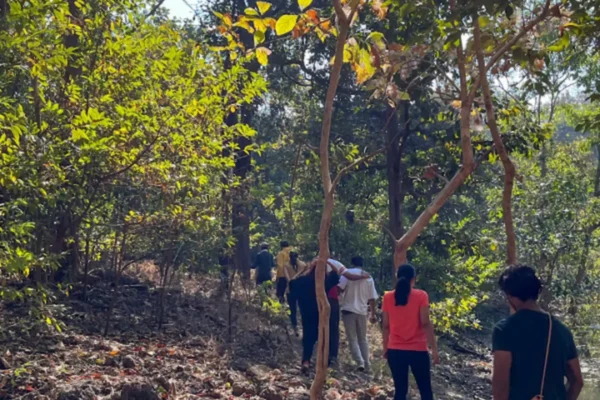
The story of the Hard Ground Barasingha, also known as the Swamp Deer, exemplifies the delicate dance between human intervention and nature’s resilience. As this majestic species teetered on the brink of extinction, conservation efforts have been instrumental in its remarkable resurgence. Yet, this journey has been marked by challenges, highlighting the complexities of safeguarding a species on the edge.
The Resilience of the Hard Ground Barasingha: An Icon of Central India’s Jungles
The Hard Ground Barasingha, also known as the Swamp Deer, stands as a testament to nature’s ability to rebound against the odds. With its distinctive antlers and striking appearance, it symbolizes the delicate balance between survival and adaptation in its Central Indian habitat.
Physical Features:
Distinguished by its unique antlers, the Hard Ground Barasingha’s branched crowns can bear up to twelve points, captivating observers with their intricate design. Its coat varies, transitioning from a reddish hue in summer to a darker shade in winter, allowing it to blend seamlessly with its environment. As it moves through the marshy landscapes, its long legs provide a graceful yet resilient gait.
Social Structure:
These majestic deer exhibit a structured social life. They form herds, often led by a dominant stag, showcasing the species’ communal nature. Within the herds, females and their young coexist, forming a network of protection. Their social interactions underscore the importance of cooperation in navigating their habitat’s challenges.
Mating Habits:
Mating rituals unveil a fascinating dance of courtship. During the rutting season, males assert dominance through vocalizations and displays of antler strength. Female Hard Ground Barasinghas are choosy, often selecting mates based on these displays of prowess. The orchestration of their mating rituals reflects the intricate dynamics of nature’s tapestry.

In the realm of Central India’s jungles, the Hard Ground Barasingha’s presence is not merely a visual spectacle. It encapsulates the intricacies of adaptation, social cohesion, and the essential role each species plays in maintaining the ecological balance. As guardians of these landscapes, it is our responsibility to ensure their survival and cherish the beauty they bestow upon the wild.
The Plight and Importance of the Hard Ground Barasingha:
Endemic to the lush landscapes of Central India, the Hard Ground Barasingha once thrived in the wetlands and grasslands. Yet, habitat loss, human encroachment, and predation pushed it to the brink of extinction. This species, with its unique antlers and striking appearance, represents a crucial link in the ecosystems it inhabits. Its grazing habits influence vegetation growth, thereby impacting various other species. Hence, its survival is pivotal for the health of the entire ecosystem.
Conservation Successes:
In the face of adversity, conservationists rallied to save the Hard Ground Barasingha. The Kanha National Park emerged as a beacon of hope, harbouring a population that became the foundation for the species’ recovery. Intensive habitat restoration, anti-poaching measures, and community engagement programs initiated by the forest department played a vital role in this endeavour. The Hard Ground Barasingha population, once dwindling, witnessed an encouraging upswing.
Challenges and Ongoing Efforts:
However, the journey has been marred by challenges. The conservation of this species necessitates a delicate balance between habitat restoration and human activities. Encroachment, competition for resources, and conflicts with local communities present significant obstacles. Moreover, genetic diversity remains a concern, as the Hard Ground Barasingha population is still relatively small. Sustaining this species requires long-term commitment and adaptive strategies.
The Role of Ecotourism in the Conservation of Barasingha:

Ecotourism has played a pivotal role in fostering a holistic approach to conservation. From engaging local communities in conservation initiatives to supporting scientific research, we have been instrumental in raising awareness about the Hard Ground Barasingha’s plight. Our ecotourism endeavours not only generate revenue for conservation but also amplify the voice of these endangered species.
Proliferation and Future Prospects:
Thanks to persistent efforts, the Hard Ground Barasingha has witnessed a resurgence in various habitats. Beyond Kanha, its populations are now found in parks like Satpura and Pench. These growing pockets offer hope for the species’ sustained recovery. Continued efforts, bolstered by public support and collaborative partnerships, hold the promise of not only preserving this emblematic species but also strengthening the ecological integrity of their habitats.
In the heart of this narrative lies the profound lesson that human intervention can be a force for good, catalyzing the revival of species teetering on the brink. The conservation journey of the Hard Ground Barasingha underscores the vital role we all play in safeguarding our natural heritage. As we celebrate the successes, we are reminded that the road to conservation is a continuous one, demanding unwavering commitment, innovative strategies, and collective action.



